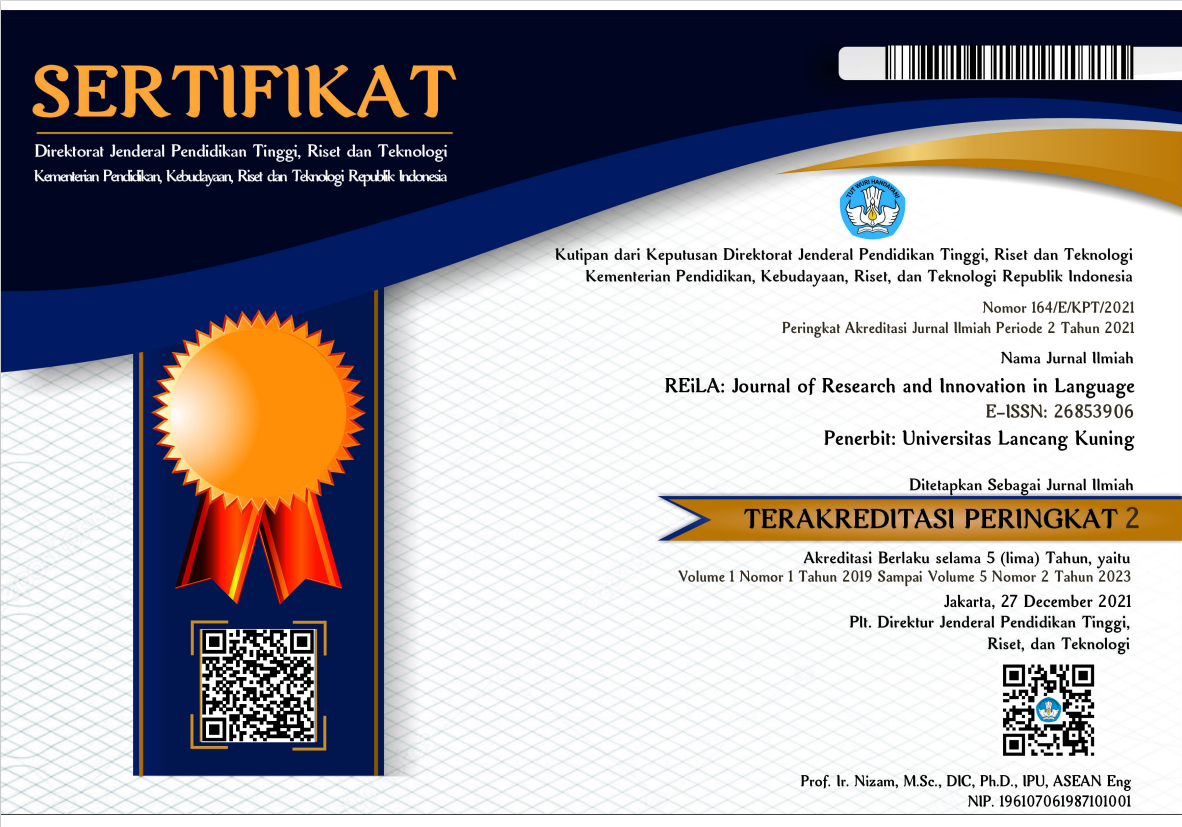Language Selection to Attract Customers’ Attention: Verbal Branding and Representation of Specific Ethnicity
Abstract
Words can motivate individuals to take action. In culinary sector, distinct ethnic verbal branding is one of the techniques to identify a restaurant brand. Specific phrases or words are selected to establish a powerful brand. This study aims to analyze the language selection for verbal branding and ethnicity representation in restaurants that use ethnic brands in Pekanbaru, one of the metropolis cities with the largest economic activities in Sumatera Island. Six restaurants were selected for their popular atmosphere, service, and cuisines authenticity specific to ethnic brand. This qualitative research was conducted from the perspective of cultural studies using an ethnolinguistic approach to collect data from three-month observations and interviews with the owners of purposively-selected restaurant to help understand the phenomenon. The results indicated that, lexically, the names of the restaurants contained ethnic words directly associated with certain ethnicities and are chosen to create a memorable brand. The analysis of associative meaning reveals that the restaurant brand represents an ethnicity with its uniqueness to produce strong branding which attracts customers. The combined lexical and associative meaning shows that restaurant branding represents not only the restaurant owners’ place of origin or ethnicity but also the authentic menus that define their culinary business. Research implications suggest the effectiveness of incorporating local words and ethnic representation in the restaurants’ names to bring in economic benefits and international branding.
Downloads
References
Abdullah, W. (2013). Etnolinguistik: teori, metode dan aplikasinya. Universitas Sebelas Maret Surakarta: Jurusan Sastra Daerah Fakultas Sastra dan Seni Rupa.
Baker, M. A., & Kim, K. (2018a). The role of language, appearance, and smile on perceptions of authenticity versus rapport. International Journal of Hospitality Management, 74, 171-179. https://doi.org/10.1016/j.ijhm.2018.04.011
Baker, M.A., Kim, K., (2018b). Heritage and authenticity in gastronomic tourism. In: Dixit, S.K. (Ed.), The Routledge Handbook of Gastronomic Tourism. Routledge.
Chaer, A. (1990). Pengantar semantik bahasa Indonesia. Rineka Cipta.
Chaer, A., & Muliastuti, L. (2009). Hakikat Semantik. Rineka Cipta.
Chen, F. F., Liu, S. Q., & Mattila, A. S. (2022). Ethnic restaurants: Bringing uniqueness to the table through handwriting. Cornell Hospitality Quarterly, 63(4), 465-478. https://doi.org/10.1177/193896552110254
Conner, M., & Armitage, C. J. (2006). Social psychological models of food choice. Frontiers in nutritional science, 3, 41-57.
Cruse, D. A. (1986). Lexical semantics. Cambridge University Press.
Erkmen, E., & Hancer, M. (2019). Building brand relationship for restaurants: An examination of other customers, brand image, trust, and restaurant attributes. International Journal of Contemporary Hospitality Management. 31(3), 1469-1487. https://doi.org/10.1108/IJCHM-08-2017-0516
Fishman, J. A. (2017). Language and ethnicity: The view from within. The handbook of sociolinguistics, 327-343.
Fitrisia, D., Sibarani, R., Mulyadi, M. U. R., & Suhairi, L. (2018) The naming of Acehnese Traditional Culinary. Humanities & Social Sciences Reviews, 8, 815-823. https://doi.org/10.18510/hssr.2020.8290
Juliandi, R. S., & Tampubolon, D. (2021). Analisis aspek ekonomi dan sosial Kota Pekanbaru sebagai kota layak huni. REVENUE Jurnal Ekonomi Pembangunan dan Ekonomi Syari'ah, 4(02), 1-15. https://doi.org/10.56998/jr.v4i02.36
Karaosmanoğlu, D. (2020). How to study ethnic food: senses, power, and intercultural studies. Journal of Ethnic Foods, 7(1), 1-7. https://doi.org/10.1186/s42779-020-00049-1
Keraf, G. (1984). Linguistik bandingan historis. Gramedia Jakarta.
Kim, D., & Jang, S. S. (2019). Ethnic food advertising formats and consumers’ responses: Picture-dominant or text-dominant?. International Journal of Hospitality Management, 82, 5-12. https://doi.org/10.1016/j.ijhm.2019.03.023
KKBI. 2016. https://www.kbbi.web.id/
Koentjaraningrat. (1996). Pengantar Antropologi I. Rineka Cipta: Jakarta.
Kridalaksana, H. (2008). Kamus Linguistik (4th ed.). Jakarta: Gramedia Pustaka Utama.
Kwon, D. Y. (2015). What is ethnic food?. Journal of ethnic foods, 2(1), 1. http://dx.doi.org/10.1016/j.jef.2015.02.001
Kwon, J., Roberts, K. R., Shanklin, C. W., Liu, P., & Yen, W. S. (2010). Food safety training needs assessment for independent ethnic restaurants: Review of health inspection data in Kansas. Food Protection Trends, 30(7), 412-421.
Marinkovic, V., Senic, V., & Mimovic, P. (2015). Factors affecting choice and image of ethnic restaurants in Serbia. British Food Journal. https://doi.org/10.1108/BFJ-09-2014-0313
Megawati, S. (2021). The influence of experiential marketing to customer loyalty at pondok patin restaurant in Pekanbaru. [Master-Thesis] Universitas Riau
Nurman, M., Hendarini, A. T., & Afrinis, N. (2019). Pengembangan usaha ikan patin di desa Batu Belah, kecamatan Kampar Riau. Proceeding of Community Development, 2, 106-110. https://doi.org/10.30874/comdev.2018.132
Palmer, J. (2008). Parmenides. Stanford Encyclopedia of Philosophy. https://plato.stanford.edu/entries/parmenides/
Rahayu, I., Suparwi, S., & Solikhin, A. (2019). Pengaruh strategi bauran pemasaran terhadap kepuasan pengunjung di de tjolomadoe convention and heritage Karangayar. Jurnal Pariwisata Indonesia, 14(2), 43-50.
Rodríguez-López, M. E., del Barrio-García, S., & Alcántara-Pilar, J. M. (2020). Formation of customer-based brand equity via authenticity: The mediating role of satisfaction and the moderating role of restaurant type. International Journal of Contemporary Hospitality Management. https://doi.org/10.1108/IJCHM-05-2019-0473
Ryu, K., & Zhong, Y. (2012). Antecedents and consequences of customers' menu choice in an Authentic Chinese restaurant context. Journal of Hospitality Marketing & Management, 21(8), 852-871. https://doi.org/10.1080/19368623.2011.615023
Santosa, M. P. S. A. (2020). Analisis penamaan kedai kopi di Surabaya: Kajian etnolinguistik. KREDO: Jurnal Ilmiah Bahasa dan Sastra, 3(2), 386-399. https://doi.org/10.24176/kredo.v3i2.4788
Sari, N. R., & Hendri, R. Komunikasi pemasaran pada usaha kuliner ikan di restoran Pondok Patin HM Yunus Pekanbaru. Jurnal Sosial Ekonomi Pesisir, 1(3), 13-21.
Susanto, P. C. (2015, November). Specific naming patterns of star hotels in Bali. In Proceedings of the Tourism and Hospitality International Conference (THIC 2015), (pp. 19-20). Universitas Ciputra Indonesia
Verhaar, J. W. M. (2001). Asas-asas linguistik. Gajah Mada University Press.
Wang, Y., Wang, L., Xue, H., & Qu, W. (2016). A review of the growth of the fast food industry in China and its potential impact on obesity. International journal of environmental research and public health, 13(11), 1112-1128. https://doi.org/10.3390/ijerph13111112
Wardhaugh, R., & Fuller, J. M. (2021). An introduction to sociolinguistics. John Wiley & Sons.
Wijaya, S. (2019). Indonesian food culture mapping: a starter contribution to promote Indonesian culinary tourism. Journal of Ethnic Foods, 6(1), 1-10. https://doi.org/10.1186/s42779-019-0009-3
Youn, H., & Kim, J. H. (2017). Effects of ingredients, names and stories about food origins on perceived authenticity and purchase intentions. International Journal of Hospitality Management, 63, 11-21. https://doi.org/10.1016/j.ijhm.2017.01.002
Zhang, L., & Hanks, L. (2018). Online reviews: The effect of cosmopolitanism, incidental similarity, and dispersion on consumer attitudes toward ethnic restaurants. International Journal of Hospitality Management, 68, 115-123. https://doi.org/10.1016/j.ijhm.2017.10.008










